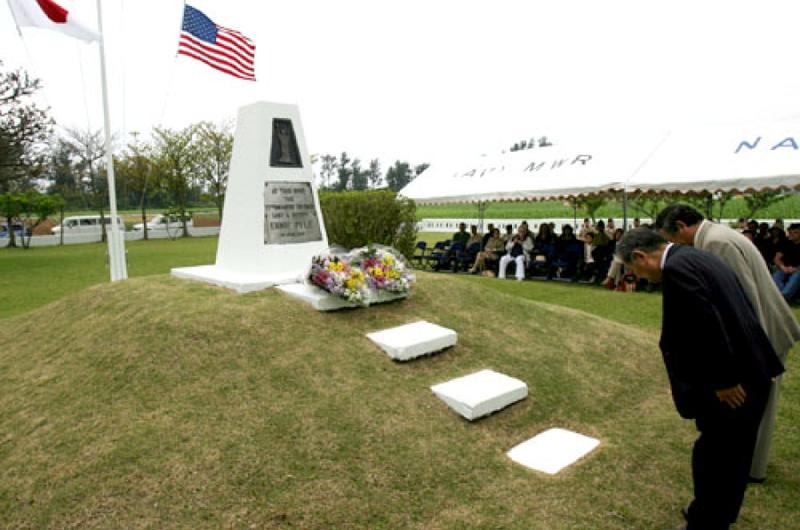60 years after his death, Ernie Pyle is still revered by servicemembers

Ie Shima mayor Seitoku Shimabukuro and assembly head Hiroaki Uchima bow after placing bouquets of flowers at the Ernie Pyle Monument during a service commemorating the 60th anniversary of Pyle’s death.
By Erik Slavin | Stars and Stripes April 19, 2005
IE SHIMA, Okinawa — Sixty years after Ernie Pyle’s death, veterans and active servicemembers still spoke with reverence Sunday about a man who turned the “average Joe” American GIs he interviewed into heroes in the eyes of millions back home.
Even among those too young to have served in World War II, the journalist’s work stands as a proud testament to the servicemembers that came before them, said many of the 50 who gathered Sunday at Ie Shima’s Ernie Pyle Monument to remember him on the 60th anniversary of his death.
Ed Zobrack, who was still a child when World War II began, said he remembers when Pyle’s stories about Europe began running in stateside newspapers. Like many others his age, the retired airman said, he read those articles diligently.
“He was in the foxholes, he was on the front lines,” said Zobrack, a member of American Legion Post 29, which sponsored the event. “He was a champion of the enlisted men and he told everyone back home about their exploits.”
Others who attended the memorial said Camp Foster commander Col. Adrienne Fraser-Darling and American Legion Commander Larry Henry spoke at the gathering about Pyle’s extraordinary career, through World War II up until his death on Ie Shima in the Battle of Okinawa’s opening month.
Pyle followed troops through North Africa in the battles and eventual victory against the Nazi “Desert Fox,” Erwin Rommel. He stayed with the troops as they liberated Sicily and mainland Italy, then continued to France through D-Day.
“Brave Men,” a collection of Pyle’s columns, illustrates how the war correspondent wrote with warmth and humanity — and often with levity and wit that lightened the mood for many.
On his way through Italy, Pyle wrote, Army Cpl. Anthony Savino had thankless assignment after thankless assignment heaped on. The “antitank” man became a part-time caravan organizer and interpreter. “Cpl. Savino takes his interpreting job so seriously he even talks about it in his sleep,” Pyle wrote. “I slept in the same cowshed with the boys, and one night I happened to wake up about 3 a.m. and I heard Savino saying, ‘Well, if we can’t use them as interpreters, let’s make guides out of them.’”
Sunday, World War II Marine veteran Lawrence White said Pyle’s dedication to the grunts is what brings him back year after year to remember him.
“He described just what the servicemembers were going through. I come back to show respect and honor for the things he did,” said White, who served at Guadalcanal, Guam, Saipan and elsewhere in the Pacific theater.
Pyle’s relationship with the troops became evident soon after his death. Servicemembers left the following inscription near where a sniper’s bullet ended his life on Ie Shima: “On this spot the 77th Infantry Division lost a Buddy. Ernie Pyle, 18 April 1945.”
Reserve American Legion member and Marine reserve Staff Sgt. Aloysius Tighe said Pyle’s dedication “made a big impression on Marines in World War II ... his example is something we still look up to today.”



